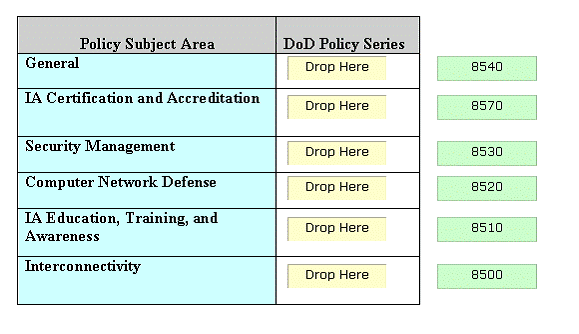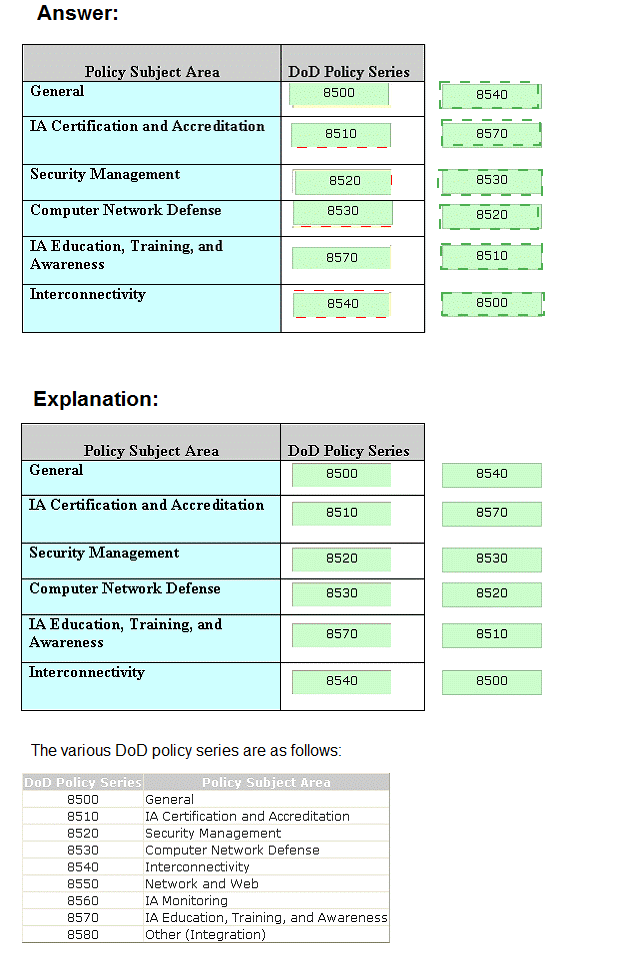
- Email support@dumps4free.com

Topic 2: Volume B
Which of the following is a standard that sets basic requirements for assessing the effectiveness of computer security controls built into a computer system?
A.
FITSAF
B.
FIPS
C.
TCSEC
D.
SSAA
TCSEC
Explanation: Trusted Computer System Evaluation Criteria (TCSEC) is a United States Government Department of Defense (DoD) standard that sets basic requirements for assessing the effectiveness of computer security controls built into a computer system. TCSEC was used to evaluate, classify, and select computer systems being considered for the processing, storage, and retrieval of sensitive or classified information. It was replaced with the development of the Common Criteria international standard originally published in 2005. The TCSEC, frequently referred to as the Orange Book, is the centerpiece of the DoD Rainbow Series publications. Answer: D is incorrect. System Security Authorization Agreement (SSAA) is an information security document used in the United States Department of Defense (DoD) to describe and accredit networks and systems. The SSAA is part of the Department of Defense Information Technology Security Certification and Accreditation Process, or DITSCAP (superseded by DIACAP). The DoD instruction (issues in December 1997, that describes DITSCAP and provides an outline for the SSAA document is DODI 5200.40. The DITSCAP application manual (DoD 8510.1- M), published in July 2000, provides additional details. Answer: A is incorrect. FITSAF stands for Federal Information Technology Security Assessment Framework. It is a methodology for assessing the security of information systems. It provides an approach for federal agencies. It determines how federal agencies are meeting existing policy and establish goals. The main advantage of FITSAF is that it addresses the requirements of Office of Management and Budget (OMB). It also addresses the guidelines provided by the National Institute of Standards and Technology (NIsT). Answer: B is incorrect. The Federal Information Processing Standards (FIPS) are publicly announced standards developed by the United States federal government for use by all non-military government agencies and by government contractors. Many FIPS standards are modified versions of standards used in the wider community (ANSI, IEEE, ISO, etc.). Some FIPS standards were originally developed by the U.S. government. For instance, standards for encoding data (e.g., country codes), but more significantly some encryption standards, such as the Data Encryption Standard (FIPS 46-3) and the Advanced Encryption Standard (FIPS 197). In 1994, NOAA (Noaa) began broadcasting coded signals called FIPS (Federal Information Processing System) codes along with their standard weather broadcasts from local stations. These codes identify the type of emergency and the specific geographic area (such as a county) affected by the emergency.
Which of the following tiers addresses risks from an information system perspective?
A.
Tier 0
B.
Tier 3
C.
Tier 2
D.
Tier 1
Tier 3
Explanation: The information system level is the tier 3. It addresses risks from an information system perspective, and is guided by the risk decisions at tiers 1 and 2. Risk decisions at tiers 1 and 2 impact the ultimate selection and deployment of requisite safeguards. This also has an impact on the countermeasures at the information system level. The RMF primarily operates at tier3 but it can also have interactions at tiers 1 and 2. Answer: A is incorrect. It is an invalid Tier description. Answer: D is incorrect. The Organization Level is the Tier 1, and it addresses risks from an organizational perspective. Answer: C is incorrect. The mission and business process level is the Tier 2, and it addresses risks from the mission and business process perspective.
Which of the following security models characterizes the rights of each subject with respect to every object in the computer system?
A.
Clark-Wilson model
B.
Bell-LaPadula model
C.
Biba model
D.
Access matrix
Access matrix
Explanation: The access matrix or access control matrix is an abstract, formal security model of protection state in computer systems that characterizes the rights of each subject with respect to every object in the system. It was first introduced by Butler W. Lampson in 1971. According to the access matrix model, the protection state of a computer system can be abstracted as a set of objects 'O', that is the set of entities that needs to be protected (e.g. processes, files, memory pages) and a set of subjects 'S' that consists of all active entities (e.g. users, processes). Further there exists a set of rights 'R' of the form r(s,o), where s S, o O and r(s,o) R. A right thereby specifies the kind of access a subject is allowed to process with regard to an object. Answer: B is incorrect. The Bell-La Padula Model is a state machine model used for enforcing access control in government and military applications. The model is a formal state transition model of computer security policy that describes a set of access control rules which use security labels on objects and clearances for subjects. Security labels range from the most sensitive (e.g.,"Top Secret"), down to the least sensitive (e.g., "Unclassified" or "Public"). The Bell-La Padula model focuses on data confidentiality and controlled access to classified information, in contrast to the Biba Integrity Model which describes rules for the protection of data integrity. Answer: A is incorrect. The Clark-Wilson model provides a foundation for specifying and analyzing an integrity policy for a computing system. The model is primarily concerned with formalizing the notion of information integrity. Information integrity is maintained by preventing corruption of data items in a system due to either error or malicious intent. The model's enforcement and certification rules define data items and processes that provide the basis for an integrity policy. The core of the model is based on the notion of a transaction. Answer: C is incorrect. The Biba model is a formal state transition system of computer security policy that describes a set of access control rules designed to ensure data integrity. Data and subjects are grouped into ordered levels of integrity. The model is designed so that subjects may not corrupt data in a level ranked higher than the subject, or be corrupted by data from a lower level than the subject.
Drag and drop the correct DoD Policy Series at their appropriate places.


The Project Risk Management knowledge area focuses on which of the following processes? Each correct answer represents a complete solution. Choose all that apply.
A.
Risk Monitoring and Control
B.
Risk Management Planning
C.
Quantitative Risk Analysis
D.
Potential Risk Monitoring
Risk Monitoring and Control
Risk Management Planning
Quantitative Risk Analysis
Explanation: The Project Risk Management knowledge area focuses on the following processes: Risk Management Planning Risk Identification Qualitative Risk Analysis Quantitative Risk Analysis Risk Response Planning Risk Monitoring and Control Answer: D is incorrect. There is no such process in the Project Risk Management knowledge area.
| Page 22 out of 70 Pages |
| Previous |